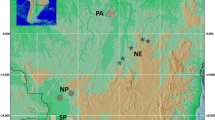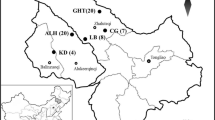Abstract
The Hyacinth Macaw (Anodorhynchus hyacinthinus) is one of 14 endangered species in the family Psittacidae occurring in Brazil, with an estimated total population of 6,500 specimens. We used nuclear molecular markers (single locus minisatellites and microsatellites) and 472 bp of the mitochondrial DNA control region to characterize levels of genetic variability in this species and to assess the degree of gene flow among three nesting sites in Brazil (Pantanal do Abobral, Pantanal de Miranda and Piauí). The origin of five apprehended specimens was also investigated. The results suggest that, in comparison to other species of parrots, Hyacinth Macaws possess relatively lower genetic variation and that individuals from two different localities within the Pantanal (Abobral and Miranda) belong to a unique interbreeding population and are genetically distinct at nuclear level from birds from the state of Piauí. The analyses of the five apprehended birds suggest that the Pantanal is not the source of birds for illegal trade, but their precise origin could not be assigned. The low genetic variability detected in the Hyacinth Macaw does not seem to pose a threat to the survival of this species. Nevertheless, habitat destruction and nest poaching are the most important factors negatively affecting their populations in the wild. The observed genetic structure emphasizes the need of protection of Hyacinth Macaws from different regions in order to maintain the genetic diversity of this species.




Similar content being viewed by others
References
Amaral ACA, Hernández MIM, Xavier BF, Bella SD (2005) Dinâmica de ninho de Arara-azul-de-lear (Anodorhynchus leari Bonaparte, 1856) em Jeremoabo, Bahia. Ornithologia 1:59–64
Amos W, Balmford A (2001) When does conservation genetics matter? Heredity 87:257–265
Bandelt HJ, Forster P, Rohl A (1999) Median-joining networks for inferring intraspecific phylogenies. Mol Biol Evol 16:37–48
Barrowclough GF, Gutiérrez RJ, Groth JG (1999) Phylogeography of spotted owl (Strix occidentalis) populations based on mitochondrial DNA sequences: gene flow, genetic structure, and a novel biogeographic pattern. Evolution 53:919–931
Birdlife International (2004) Anodorhynchus hyacinthinus. In: IUCN 2006. 2006 IUCN Red List of Threatened Species. http://www.iucnredlist.org. Cited 10 July 2006
Birdlife International (2006) Anodorhynchus leari. http://www.birdlife.org. Cited 25 July 2006
Birky CW, Fuerst P, Maruyama T (1989) Organelle gene diversity under migration, mutation, and drift: equilibrium expectations, approach to equilibrium, effects of heteroplasmic cells, and comparison to nuclear genes. Genetics 121:613–627
Bruford MW, Hanotte O, Brookfield JFY, Burke T (1992) Single locus and multilocus DNA fingerprinting. In: Hoezel CAR (ed) Molecular genetic analysis of populations: a practical approach. Oxford University Press, New York
Caparroz R (2003) Filogeografia, estrutura e variabilidade genética da Arara-canindé (Ara ararauna, Psittaciformes: Aves) no Brasil baseadas na análise de DNA mitocondrial e de DNA nuclear. Ph. D. Dissertation, Universidade de São Paulo, São Paulo, Brazil
Chesser RK, Baker RJ (1996) Effectives sizes and dynamics of uniparentally and biparentally inherited genes. Genetics 144:1225–1235
Collar NJ (1997) Family Psittacidae (parrots). In: del Hoyo J, Elliott A, Sargatal J (eds) Handbook of the birds of the world: sandgrouse to cuckoos. Lynx Edicions, Barcelona
Collar NJ, Gonzaga LP, Krabbe N, Nieto AM, Naranjo LG, Parker TA, Wege DC (1992) Threatened birds of the Americas: The ICBP/IUCN red data book. Smithsonian, Cambridge
Eberhard JR, Wright TF, Bermingham E (2001) Duplication and concerted evolution of the mitochondrial control region in the parrot genus Amazona. Mol Biol Evol 18:1330–1342
Evanno G, Regnaut S, Goudet J (2005) Detecting the number of clusters of individuals using the software STRUCTURE: a simulation study. Mol Ecol 14:2611–2620
Evans BEI, Ashley J, Marsden SJ (2005) Abundance, habitat use, and movements of Blue-winged Macaws (Primolius maracana) and other parrots in and around an Atlantic forest reserve. Wilson Bull 117:154–164
Excoffier L, Smouse PE, Quattro JM (1992) Analysis of molecular variance inferred from metric distances among DNA haplotypes: application to human mitochondrial DNA restriction data. Genetics 131:479–491
Falush D, Stephens M, Pritchard JK (2003) Inference of population structure using multilocus genotype data: linked loci and correlated allele frequencies. Genetics 164:1567–1587
Faria PJ, Miyaki CY (2006) Molecular markers for population genetic analyses in the family Psittacidae (Psittaciformes, Aves). Genet Mol Biol 29:231–240
Forshaw JM (1989) Parrots of the world. Landsdowne editions, Melbourne
Frankham R, Ballou JD, Briscoe DA (2002) Introduction to conservation genetics. Cambridge Press, New York
Fu Y (1997) Statistical tests of neutrality of mutations against population growth, hitchhiking and background selection. Genetics 147:915–925
Glenn TC, Stephan W, Braun MJ (1999) Effects of a population bottleneck on whooping crane mitochondrial DNA variation. Conserv Biol 13:1097–1107
González JA (2003) Harvesting, local trade and conservation of parrots in the Northeastern Peruvian Amazon. Biol Conserv 114:437–446
Greenwood PJ (1980) Mating systems, philopatry and dispersal in birds and mammals. Anim Behav 28:1140–1162
Guedes NMR (1993) Biologia reprodutiva da Arara azul (Anodorhynchus hyacinthinus) no Pantanal-MS, Brasil. MSc Dissertation, Universidade de São Paulo, São Paulo, Brasil
Guedes NMR (2004) Araras azuis: 15 anos de estudos no Pantanal. In: IV Simpósio sobre Recursos Naturais e Sócio-econômicos do Pantanal, Corumbá, MS
Guedes NMR, Harper LH (1995) Hyacinth macaws in the Pantanal. In: Abramson J, Speer L, Thomsen JB (eds) The large macaws: their care, breeding and conservation. Raintree Publications, Hong Kong
Haig SM (1998) Molecular contributions to conservation. Ecology 79:413–425
Hendrickson S, Bleiweiss R, Matheus JC, Matheus LS, Jácome NL, Pavez E (2003) Low genetic variability in the geographically widespread Andean condor. Condor 105:1–12
Johnson JA, Bellinger MR, Toepfer JE, Dunn P (2004) Temporal changes in allele frequencies and low effective population size in greater prairie-chickens. Mol Ecol 13:2617–2630
Lande R (1988) Genetics and demography in biological conservation. Science 241:1455–1460
Munn CA, Thomsen JB, Yamashita C (1989) The Hyacinth macaw. In: Chadler WD (ed) Audubon wildlife report. Academic Press, New York
Myers MC, Vaughan C (2004) Movements and behavior of scarlet macaws (Ara macao) during the post-fledging dependence period: implications for in situ versus ex situ management. Biol Conserv 118:411–420
Nader W, Werner D, Wink M (1999) Genetic diversity of scarlet macaws Ara macao in reintroduction studies for threatened populations in Costa Rica. Biol Conserv 87:269–272
Nei M (1987) Molecular evolutionary genetics. Columbia University Press, New York
Nei M, Kumar S (2000) Molecular evolution and phylogenetics. Oxford University Press, New York
Nichols RA, Beaumont MA (1996) Is it ancient or modern history that we can read in the genes? In: Hochberg M, Clobert J, Barbault R (eds) Aspects of the genesis and maintenance of biological diversity. Oxford University Press, Oxford
Pinho JB, Nogueira FMB (2003) Hyacinth Macaw (Anodorhynchus hyacinthinus) reproduction in the northern Pantanal, Mato Grosso, Brazil. Ornitol Neotrop 14:29–38
Pritchard JK, Stephens M, Donnelly P (2000) Inference of population structure using multilocus genotype data. Genetics 155:945–959
Prugnolle F, Meeus T (2002) Inferring sex-biased dispersal from population genetic tools: a review. Heredity 88:165–169
Renton K (2002) Seasonal variation in occurrence of macaws along a rainforest river. J Field Ornithol 73:15–19
Rogers AR, Harpending H (1992) Population growth makes waves in the distribution of pairwise genetic differences. Mol Biol Evol 9:552–569
Rozas J, Sanchez-Delbarrio JC, Messeguer X, Rozas R (2003) DNASP, DNA polymorphism analyses by the coalescent and other methods. Bioinformatics 19:2496–2497
Sambrook J, Fritsch EF, Maniatis T (1989) Molecular cloning: a laboratory manual. Cold Spring Harbor Laboratory Press, New York
Schneider S, Excoffier L (1999) Estimation of demographic parameters from the distribution of pairwise differences when the mutation rates vary among sites: application to human mitochondrial DNA. Genetics 152:1079–1089
Schneider S, Roessli D, Excoffier L (2000) Arlequin 2.0: a software for population genetic data analysis. Genetics and Biometry Laboratory, University of Geneva, Switzerland
Seixas GHF, Guedes NMR, Martinez J, Prestes NP (2002) Uso de radiotelemetria no estudo de psitacídeos. In: Galetti M, Pizo MA (eds) Ecologia e Conservação de Psitacídeos no Brasil. Melopsittacus Publicações Científicas, Belo Horizonte
Sick H (1997) Ornitologia Brasileira. Editora Nova Fronteira, Rio de Janeiro
Slatkin M (1985) Rare alleles as indicators of gene flow. Evolution 39:53–65
Spielman DB, Brook W, Frankham R (2004) Most species are not driven to extinction before genetic factors impact them. Proc Natl Acad Sci USA 101:15621–15624
Tajima F (1989) Statistical method for testing the neutral mutation hypothesis by DNA polymorphism. Genetics 158:1147–1155
Tavares ES, Yamashita C, Miyaki CY (2004) Phylogenetic relationships among some neotropical parrot genera (Psittacidae, Aves) based on mitochondrial sequences. Auk 121:230–249
Vaughan C, Nemeth NM, Cary J, Temple S (2005) Response of a Scarlet Macaw Ara macao population to conservation practices in Costa Rica. Bird Conserv Int 15:119–130
Westemeier RL, Brawn JD, Simpson SA, Esker TL, Jansen RW, Walk JW, Kershner EL, Bouzat JL, Paige KN (1998) Tracking the long-term decline and recovery of an isolated population. Science 282:1695–1697
Wright TF, Wilkinson GS (2001) Population genetic structure and vocal dialects in an amazon parrot. Proc R Soc Lond B 268:609–616
Wright TF, Rodriguez AM, Fleischer RC (2005) Vocal dialects, sex-biased dispersal, and microsatellite population structure in the parrot Amazona auropalliata. Mol Ecol 14:1197–1205
Yamashita C (1997) Anodorhynchus macaws as followers of extinct megafauna: a hypothesis. Ararajuba 5:176–182
Yamashita C, Valle MP (1993) On the linkage between Anodorhynchus macaws and palm nuts, and the extinction of the Glaucous macaws. Bull B O C 113:53–60
Acknowledgments
We thank Anita Wajntal and Mike W. Bruford for encouragement and invaluable suggestions on the manuscript. Sérgio L. Pereira, Sérgio Matioli, Elisângela P. Quedas, Antônia M. P. Cerqueira, Andréa Bernardino and Adriana R. Oliveira-Marques for support during the lab work and statistical analysis. Scott K. Davis generously provided unpublished microsatellites primers sequences. Luís G. Maluf and (IBAMA) helped with the blood samples collection. This study was supported by FAPESP, CNPq, CAPES and Fundação BioBrasil. CYM has a CNPq research productivity fellowship.
Author information
Authors and Affiliations
Corresponding author
Rights and permissions
About this article
Cite this article
Faria, P.J., Guedes, N.M.R., Yamashita, C. et al. Genetic variation and population structure of the endangered Hyacinth Macaw (Anodorhynchus hyacinthinus): implications for conservation. Biodivers Conserv 17, 765–779 (2008). https://doi.org/10.1007/s10531-007-9312-1
Received:
Accepted:
Published:
Issue Date:
DOI: https://doi.org/10.1007/s10531-007-9312-1




